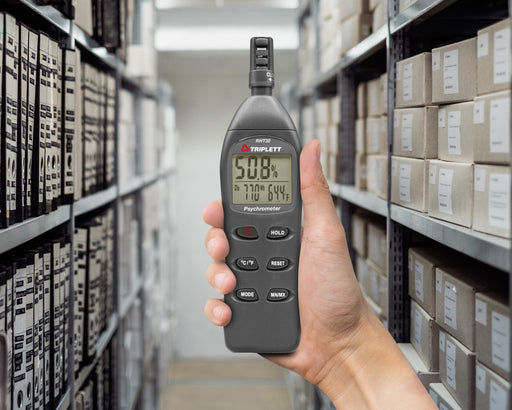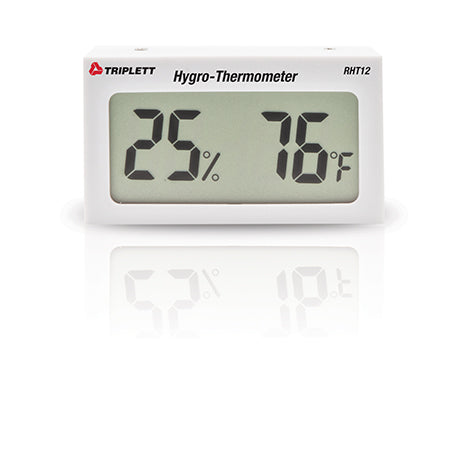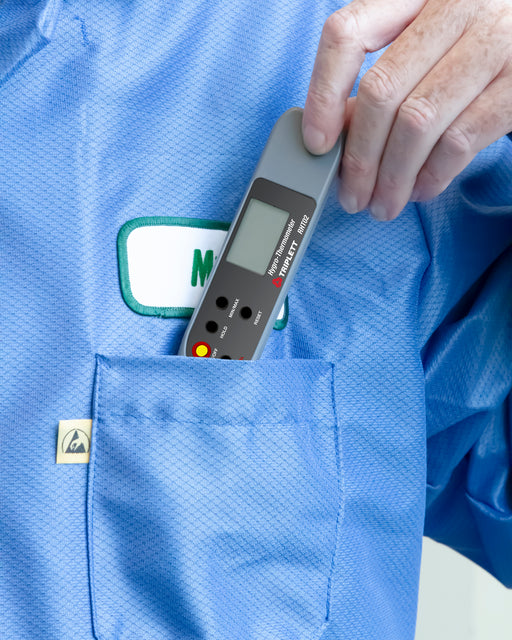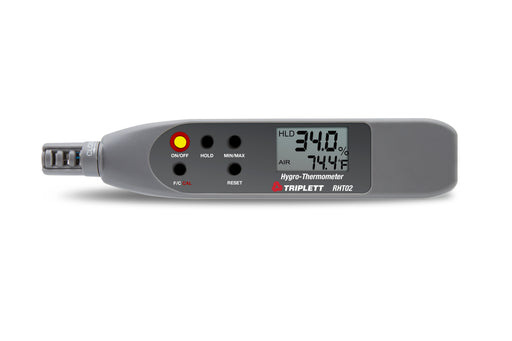Know More About Triplett IR Thermometer
What is an Infrared Thermometer?
An infrared thermometer, also known as a non-contact thermometer or temperature gun, is a device used to measure temperature from a distance without making physical contact with the object being measured. By using infrared technology, it detects and measures the thermal radiation emitted by objects.
Infrared thermometers are widely used in various industries and applications, including HVAC (heating, ventilation, and air conditioning), food safety, automotive diagnostics, medical settings, electrical systems, and many more. They provide quick and convenient temperature readings without the need for physical contact, making them versatile tools for temperature measurement.
How does an IR Thermometer work?
An IR thermometer works on the simple principle. It senses the infrared energy emitted by the surface under test. All materials emit infrared energy and the amount of energy emitted is proportional to the temperature of the material. The meter simply converts the infrared it collects into a temperature display. Generally, an IR thermometer features a detector, which is also known as a thermopile. This thermopile converts the IR rays into heat, which is then converted into electricity and measured. So, what you see on display is the amount of electricity produced by the rays emitted by the object under question. This reading is often produced in seconds, which means the infrared thermometer is the best way to gather information in different scenarios.
What are the advantages of an IR thermometer?
IR thermometers are ideal for non-contact measurements are ideal for all surfaces. They are extremely fast. They can easily measure moving objects and safe distance. They help avoid contamination which is otherwise a concern in several industries. All our digital IR thermometers are developed to withstand harsh work environments.
Can you use an infrared thermometer on humans?
Yes, infrared thermometers can be used to detect a human body’s temperature. These non-contact thermometers are placed on the forehead of adults and kids and are perfectly safe to use. The thermometers measure the infrared energy emitted by the body.
What is the normal temperature of the forehead?
The normal temperature of the forehead lies in the range of 31°C (87.8°F) to 35.6°C (96.8°F). Temperatures higher than 37°C (98.6°F) may indicate fever.
How to get the best results with infrared thermometers?
Our selection features some of the best digital thermometers with different specifications. However, to get the best results, you need to keep the following things in mind:
- Consider the Spot (D/S) Ratio: The ratio can vary across models and slightly with distance. Ensure to check the label on the thermometer.
- Get Clarity About the Laser Pointer: Most handheld infrared thermometers have laser pointers, which give you an idea of the approximate center of the measurement area. Often, people confuse laser pointers with actual temperature measurements. It has nothing to do with the actual temperature measurement. The thermometer doesn’t measure the area illuminated by the laser.
- Be Careful When Using Them on Shiny Objects: Measuring the temperature of shiny objects is quite challenging. The reflections from glossy surfaces can affect the accuracy of temperature measurement. To get it right, it is always better to put a piece of non-reflective tape over the shiny surface to get an accurate measurement.
- Watch for Steam or Dust: Steam or dust on the surface to be measured will affect the accuracy of readings. This is because IR energy will be deflected before hitting the thermometer.
- Watch for Scratches: The scratched or fogged display on the digital thermometer can impair the readings. Ensure to clean the display before using it.
- Allow Temperature to Set in Surroundings Before Used: The accuracy of a non-contact infrared thermometer will vary if you use it immediately after bringing it out from extremely cold or hot storage. In this condition, it is always recommended to leave the thermometer in surrounding where the temperature is to be measured for at least 20 minutes before using it again.
What are the applications of infrared thermometers?
Our digital thermometers are designed carefully and utilized for a variety of applications. They can be used to determine the following:
- Measuring the temperature of the human body
- Identifying faulty terminations in electrical circuits that use high power electricity
- Identifying hot spots in any high power electronic equipment
- Capturing readings of a process
- Identifying leaks in any high-pressure vessel
- Identifying working issues or other problems in electrical switchgear
- Checking on circuit breakers that may be overloaded
Factors to Consider When Choosing Infrared Thermometers
IR thermometers are non-contact devices used to measure surface temperatures of indoor as well as outdoor entities. Triplett offers a range of Hygro-IR thermometers that measure relative temperature as well as humidity. While we help you select the right one based on your application here are some pointers to consider when selecting an infrared thermometer.
- You can choose an IR thermometer for measuring temperature of any type of surface. However, if your application has exposure to moisture or you need to also measure humidity, opt for our Hygro-IR thermometer which measures both parameters accurately.
- Emissivity is an important aspect when choosing IR thermometers. The emissivity measurement range is from 0 to 1. It is generally in the lower range for shiny and glossy surfaces. We offer thermometers with variable settings for emissivity, which you can set based on the surface type. These are especially suitable for surfaces that are highly reflective and shiny. This largely depends on the type of surface material such as glass, wood, paint used, and more.
- Temperature range is a crucial parameter for selection. The minimum and maximum temperature measurement limits as well as the accuracy level (in %) over the range for any thermometer is mentioned by the manufacturer. For instance, some thermometers may be less accurate by about 2%-3% at extremely elevated temperatures. One needs to know the level of accuracy required in a particular application as well as the operating temperature range.
- Target surface distance and spot, also called D:S ratio, is another important parameter to consider. Infrared thermometers have a laser pointer which points to the field of view or spot center. Hence, to select the right IR thermometer, you need to understand the field of view. The more the distance of the thermometer from the target surface, the wider is the field of view. If your target is to measure a particular area on the surface, then the field of view must reduce. Whatever area is in the spectrum of that thermometer will be measured.
So, when selecting an IR thermometer, you need to know the distance you need to keep from the surface and the actual size of the target object.
What is Field of View or Distance to Spot (D/S) ratio?
The IR sensor beam can be thought of as the beam of a flashlight; the closer a flashlight is to a wall, the smaller the light spot; the further from the wall, the larger the spot. If the D/S ratio of a given IR thermometer is 10:1, the spot will be a 1” diameter circle when the meter is held 10” from the surface. At a 20”distance the spot will be 2” in diameter, and so on. The surface being measured should always be larger than the spot size for accurate measurements.
Max hold indicates and holds the peak temperature for easy identification of hot spots.
Browse More Building, Maintenance & Environmental Collections
Inspection & Laser Distance Meters:
| Industrial Borescope Camera | Photo & Contact Tachometers |
| Manometers | Laser Distance Meters |
Gas Meters:
| Natural Gas Detector and Pen | Formaldahyde Meters | Co & Co2 Meters |
Environmental Meters:
| Sound & Noise Level Meters | Humidity Indicators & Meters | Hygro-Thermometers |
| Portable Particle Counters | Moisture Meters | Light Intensity Meters |
| Windmill Anemometers | Digital Hygrometer |
Water Quality:
| PH and Conductivity Meters |







